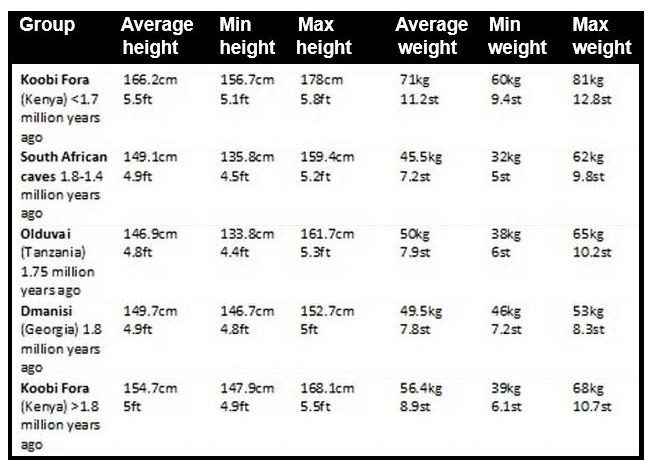Humans that lived millions of years ago had variations in height similar to today's humans and weren't four foot-tall persons that got taller and heavier as they evolved over time.
A new study carried out by researchers from the Universities of Cambridge in England and Tübingen in Germany questioned the prevailing theory early humans were small and became taller and longer-legged in response to evolution.
Researchers claim the height of early humans that lived in this time frame ranged from 142 cm (4 feet 8 inches) to 183 cm (6 feet), which is similar to the heights of modern humans.
This is the first study in two decades to compare the height and weight of humans that lived between 2.5 million and 1.5 million years ago.
The scientists said their new research method of using small fragments of fossils to estimate height and body mass revealed early humans came in many weights and heights, similar to modern humans.
They compared fossil measurements from sites in Georgia, South Africa, Tanzania and Kenya. They found there was considerable regional variation in the weight and height of early humans during the Pleistocene epoch (from about 2,588,000 to 11,700 years ago).
They found some groups such as those living in South African caves averaged just 4.8 feet in height. On the other hand, a number of fossils found in Kenya's Koobi Fora region showed these humans were nearly 6 feet tall.
The new study also shows the main increase in body size occurred tens of thousands of years after Homo erectus migrated from Africa, and primarily in the Koobi Fora region.
"The evolution of larger bodies and longer legs can thus no longer be assumed to be the main driving factor behind the earliest excursions of our genus to Eurasia", said co-author, PhD student Manuel Will, who works at the Department of Early Prehistory and Quaternary Ecology at Tübingen.
The study is the first that used many minuscule fossils (some as small as tiny ankle bones and toes measuring no more than 5 cm) to estimate body size.
Co-author Dr. Jay Stock, from the Department of Archaeology and Anthropology at the University of Cambridge, said what they saw "was perhaps the beginning of a unique characteristic of our own species - the origins of diversity."
"It's possible to interpret our findings as showing that there were either multiple species of early human, such as Homo habilis, Homo ergaster and Homo rudolfensis, or one highly diverse species. This fits well with recent cranial evidence for tremendous diversity among early members of the genus Homo."
"If someone asked you 'are modern humans 6 foot tall and 70kg?' you'd say 'well some are, but many people aren't,' and what we're starting to show is that this diversification happened really early in human evolution."
Dr. Stock said this significant size shift to much heavier, taller individuals occurred primarily in one particular place, at Koobi Fora around 1.7 million years ago.
"That means we can now start thinking about what regional conditions drove the emergence of this diversity, rather than seeing body size as a fixed and fundamental characteristic of a species."



























